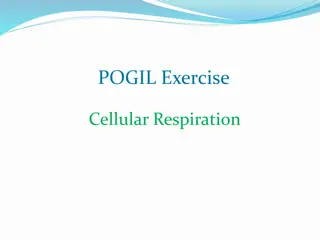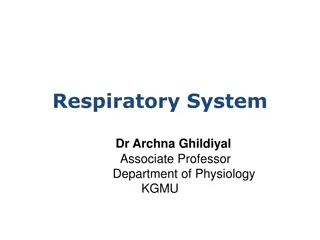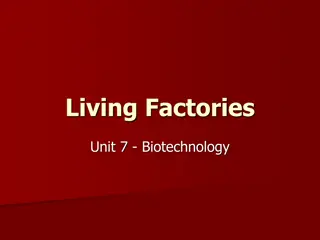Respiration
The definition and role of aerobic respiration, the overall sequence of reactions for glucose, and the two-stage process. Explore the concepts of anaerobic respiration and fermentation, including the role of microorganisms in industrial fermentation. Discover the cellular location of each stage and
0 views • 11 slides
Insect Abdominal Structures and Appendages: An Overview
The abdomen of insects plays crucial roles in respiration, reproduction, digestion, excretion, and metabolism. The number of abdominal segments varies across species, with reductions and modifications seen in different insect groups. From the propodeum to pregential and postgenital segments, each pa
2 views • 6 slides
Overview of EU Timber Regulation (EUTR) 995/2010 and its Application in Italy
The EU Timber Regulation (EUTR) 995/2010 aims to combat illegal timber trade by ensuring that timber placed on the European market is from legal sources. Applicable to most wood materials regardless of origin, the regulation requires due diligence in the timber supply chain. Italy implemented the re
2 views • 44 slides
Investigating Dehydrogenase Activity Using Yeast
This investigation focuses on exploring respiration in yeast by tracking the breakdown of glucose using dehydrogenase enzymes. The experiment involves immobilizing yeast into gel balls and measuring the change in color of resazurin dye to quantify the rate of respiration. Safety measures, risk asses
2 views • 11 slides
Cellular Respiration and Metabolism in Living Organisms
Cellular respiration is a vital process in all living cells, producing energy through chemical reactions. Metabolism, consisting of anabolism and catabolism, maintains growth and function. ATP plays a central role as energy currency in cells. Through stages like glycolysis and the Krebs cycle, cellu
1 views • 16 slides
Aerobic Respiration and Cell Structures
Explore the process of aerobic respiration, why we need oxygen for energy production, and the importance of cell structures in this metabolic pathway. Discover the role of key organelles like mitochondria and the cell membrane, as well as the differences between animal and plant cells in respiration
0 views • 10 slides
Cellular Respiration and Oxygen Delivery
Cellular respiration, a vital process for organ survival, involves mitochondria performing cellular respiration by utilizing glucose and oxygen. Glucose is derived from diet or body breakdown, while oxygen enters through the respiratory system, facilitated by red blood cells in the circulatory syste
0 views • 8 slides
Respiration in Mollusca: Adaptations to Different Habitats
Mollusca exhibit various modes of respiration depending on their habitat - aquatic, terrestrial, or amphibious. Different respiratory organs are modified accordingly, such as ctenidia or gills for aquatic species, pulmonary sac for aerial species, and mantle or integument for those lacking specific
0 views • 17 slides
The Basics of Life: Understanding Biology and Life Functions
Biology is the study of life, which involves understanding the characteristics that define living organisms. These characteristics include nutrition, transport, respiration, excretion, synthesis, regulation, and growth. Each of these life functions is essential for the survival and functioning of al
0 views • 14 slides
Regulation of Extracellular Fluid Volume: A Comprehensive Overview
Understanding the intricate mechanisms involved in the regulation of extracellular fluid volume is essential for maintaining normal body function. This includes sensor and effector roles in renal regulation, the influence of aldosterone on Na+ reabsorption, the significance of Na+ balance, and the i
3 views • 22 slides
The Respiratory System and Its Functions
Within the complex respiratory system, the goal is to provide oxygen to tissues and remove CO2. It consists of airways, muscles, and centers. Functions include gas exchange, phonation, and pulmonary defense. The system also performs non-respiratory functions like converting Angiotensin I to II, regu
3 views • 29 slides
Overview of Cellular Respiration Pathways and ATP Generation
Cellular respiration involves key processes like the Tricarboxylic Acid Cycle (TCA), Electron Transport Chain, and ATP generation pathways. The TCA cycle utilizes Acetyl-CoA to produce energy-rich molecules, while the Electron Transport Chain facilitates ATP synthesis through oxidative phosphorylati
0 views • 18 slides
Cellular Respiration Through POGIL Activities
Dive into the world of cellular respiration through POGIL activities that cover topics such as glycolysis, Krebs Cycle, Electron Transport System, and more. Discover critical thinking questions and application problems related to cellular respiration processes and their real-world implications.
0 views • 6 slides
Emerging Trends in Regulation and Credentialing for Advanced Practice Nursing
Explore the evolving landscape of regulation and credentialing in advanced practice nursing, including inconsistencies in titles, the debate between regulation and credentialing, and the challenges and purposes of regulation. Discover the impact on roles, education, and patient safety in this rapidl
0 views • 22 slides
Regulation of Blood Glucose and Its Importance in Maintaining Health
Blood glucose regulation is crucial for energy supply in the body, particularly for brain function. Understanding the balance of glucose entering and leaving the blood through processes like absorption, glycogenolysis, and gluconeogenesis is vital. Hormones like insulin and glucagon play key roles i
0 views • 10 slides
Anaerobic Respiration in Cell Biology - Year 10 Science Lesson
Exploring the concepts of anaerobic respiration in cell biology with Ms. Merrall. Learn about the differences between aerobic and anaerobic respiration, muscle fatigue, and oxygen debt. Discover the importance of respiration for survival, building upon previous knowledge and linking to various topic
0 views • 20 slides
Neural Control of Respiration in the Respiratory System
The lecture discusses the regulation of respiration, focusing on the neural control of breathing rhythm, ramp signals, lung receptors, and the role of different groups of neurons in the respiratory center. Key topics include inspiratory ramp signals, controlling the rate of respiration, and the func
0 views • 35 slides
Regulation of Disinformation in the European Union: A Comprehensive Overview
The discussion covers the regulation of disinformation in the European Union, focusing on freedom of expression, legitimate restrictions on untruthful speech, media regulation provisions, and the code of practice on disinformation. It delves into key aspects such as hate speech, right of reply, regu
10 views • 15 slides
Cellular Respiration Through Investigation
Explore the key concepts related to cellular respiration, including the substances needed, products produced, sources of substances, the respiration equation, effects of exercise, and comparison with photosynthesis. Engage in practical activities like investigating the factors affecting respiration
1 views • 24 slides
Enhancing Self-Regulation for Formative Assessment through Social and Emotional Learning
Explore the significance of self-regulation in formative assessment, understand key concepts like self-control, emotional competence, and perseverance. Discover actionable strategies to implement self-regulation interventions with students and train other adults effectively. Future orientation and s
0 views • 25 slides
Neural Control of Respiration in the Respiratory System
Explore the intricate mechanisms of neural control of respiration within the respiratory system, focusing on key components such as the respiratory center in the medulla and the role of inspiratory ramp signals in regulating breathing rhythms. Gain insights into the automatic and voluntary aspects o
1 views • 35 slides
Incentive Regulation in Utility Management
Incentive regulation in utility management involves various approaches such as Rate of Return Regulation (RORR), Price Cap Regulation, and Performance-based Regulation. Each method has its pros and cons, requiring careful consideration based on the specific setting. Rate hearings are essential quasi
2 views • 18 slides
The Fascinating World of Food Fermentation
Explore the rich history and benefits of fermentation, from the early nomads' discovery of cheese and yogurt to Louis Pasteur's groundbreaking work. Learn about the different types of respiration, microbial fermentation in food production, and the energy-releasing process of cell respiration. Discov
0 views • 13 slides
Enhancing Self-Regulation Skills in Children: Strategies and Tips
Understanding and fostering self-regulation in children is crucial for their development. Self-regulation involves controlling impulses, focusing, and shifting between tasks. This article delves into the internal mechanisms of self-regulation, such as executive function, and provides practical tips
1 views • 22 slides
Respiration and Breathing Process
Respiration is the vital process of inhaling and exhaling air to facilitate the exchange of oxygen and carbon dioxide in the body. It involves external and internal respiration, with mechanisms such as costal and diaphragmatic breathing. The regulation of breathing is controlled by the respiratory c
0 views • 21 slides
Cellular Respiration in Plants and Animals
Explore the intricate processes of photosynthesis and cellular respiration, uncovering how plants and animals utilize glucose, oxygen, and energy to sustain life. Discover the essential role of ATP production and the interdependent relationship between carbon dioxide and oxygen in the environment.
0 views • 12 slides
The Insect Gas Exchange System
The insect gas exchange system involves spiracles, tracheae, and tracheoles that facilitate the exchange of gases to support respiration in insects. Spiracles lined with chitin control airflow, while tracheae and tracheoles enable oxygen to dissolve into the haemolymph through passive diffusion, sup
0 views • 18 slides
Yeast: The Living Organism and Its Respiration Processes
Explore the world of Saccharomyces cerevisiae (yeast) as a single-celled fungus that exists on all living matter. Learn about its genetic similarities to humans, its basic survival needs, and the processes of aerobic and anaerobic respiration, including fermentation. Discover how yeast, like us, rel
0 views • 26 slides
The Respiratory System and Its Functions
The respiratory system is vital for gas exchange in the body, involving processes like pulmonary ventilation, external and internal respiration. It includes organs like the nose, pharynx, larynx, and trachea, which help in conducting air to the alveoli. This system facilitates the exchange of oxygen
1 views • 14 slides
Grodins Pro Kumar's Model of Respiration
Explore the historical background and compartments of Grodins Pro Kumar's modeling of respiration, from differing breathing rates to the layout and assumptions of lungs, brain, and soft tissue. Learn how the homogeneous system is applied and the methods used to analyze this complex respiratory model
0 views • 18 slides
Cyanide's Impact on Respiration Through Enzyme Inhibition
Cyanide, a noncompetitive inhibitor of the enzyme cytochrome c oxidase, disrupts electron transport in respiration by binding to the iron cofactor and blocking electron transfer to oxygen. This lethal effect was utilized in gas chambers during WWII, underscoring the crucial role of enzyme function i
0 views • 7 slides
Animal Temperature, Respiration, and Pulse Recording Guide
Learn how to record the temperature, respiration, and pulse in animals for diagnosing febrile diseases and monitoring health. Understand the techniques, precautions, factors affecting temperature, and causes of hypothermia in animals. Follow Dr. Ranveer Kumar Sinha's comprehensive instructions to en
0 views • 20 slides
Cellular Respiration: Energy Production in Organisms
Organisms can be classified into autotrophs that use sunlight for photosynthesis and heterotrophs that rely on consuming food. Regardless of food source, all organisms obtain energy through cellular respiration, a process that converts stored chemical energy into ATP. This energy currency is essenti
0 views • 21 slides
Cell Respiration and the Importance of Food in Biology
Cell respiration is a vital process that releases energy by breaking down glucose in the presence of oxygen. Food provides essential building blocks and energy for growth and reproduction. The chemical energy in food is significant, as one gram of sugar can release a substantial amount of heat energ
0 views • 17 slides
Cellular Respiration and Fermentation Processes
Cellular respiration is the energy-releasing process in which organisms take in glucose and oxygen to produce carbon dioxide, water, and energy. This process is vital for all living organisms. Photosynthesis and respiration are opposite processes, with respiration requiring the products of photosynt
0 views • 10 slides
Agricultural and Veterinary Chemicals Regulation in Australia - Overview
The regulation of agricultural and veterinary chemicals in Australia is overseen by the Australian Pesticides and Veterinary Medicines Authority (APVMA), established in 1993. The APVMA is responsible for assessing and registering pesticides and veterinary medicines to ensure their safety and effecti
0 views • 15 slides
Traffic Regulation Orders for Public Rights of Way in Essex
Traffic Regulation Orders (TROs) are essential for temporarily or permanently restricting public rights of way in Essex under the Road Traffic Regulation Act 1984. Temporary Traffic Regulation Orders (TTROs) are used for short-term restrictions due to works or safety reasons. The TTRO process involv
3 views • 15 slides
The Respiratory System and the Process of Respiration
The respiratory system is vital for breathing as it helps in the exchange of oxygen and carbon dioxide. This system consists of organs such as the lungs, bronchi, and alveoli. The process of respiration involves inhaling air through the nose or mouth, passing it through the trachea and bronchi into
0 views • 5 slides
Regulation Proposal to Combat Deforestation and Forest Degradation in the European Union
The European Commission is proposing a regulation to prevent the entry and export of commodities linked to deforestation and forest degradation. This aligns with political commitments such as the European Green Deal and the Farm to Fork Strategy. Existing legislation like the FLEGT Regulation and th
1 views • 32 slides
Overview of the Respiratory System Functions and Anatomy
The respiratory system has vital functions such as respiration, smell, filtration/defense, sound & speech production, and waste elimination. It consists of external (root, bridge, apex, and nostrils) and internal components (nasal cavity, pharynx, larynx). The nose/nasal cavity provides an airway fo
0 views • 37 slides







































